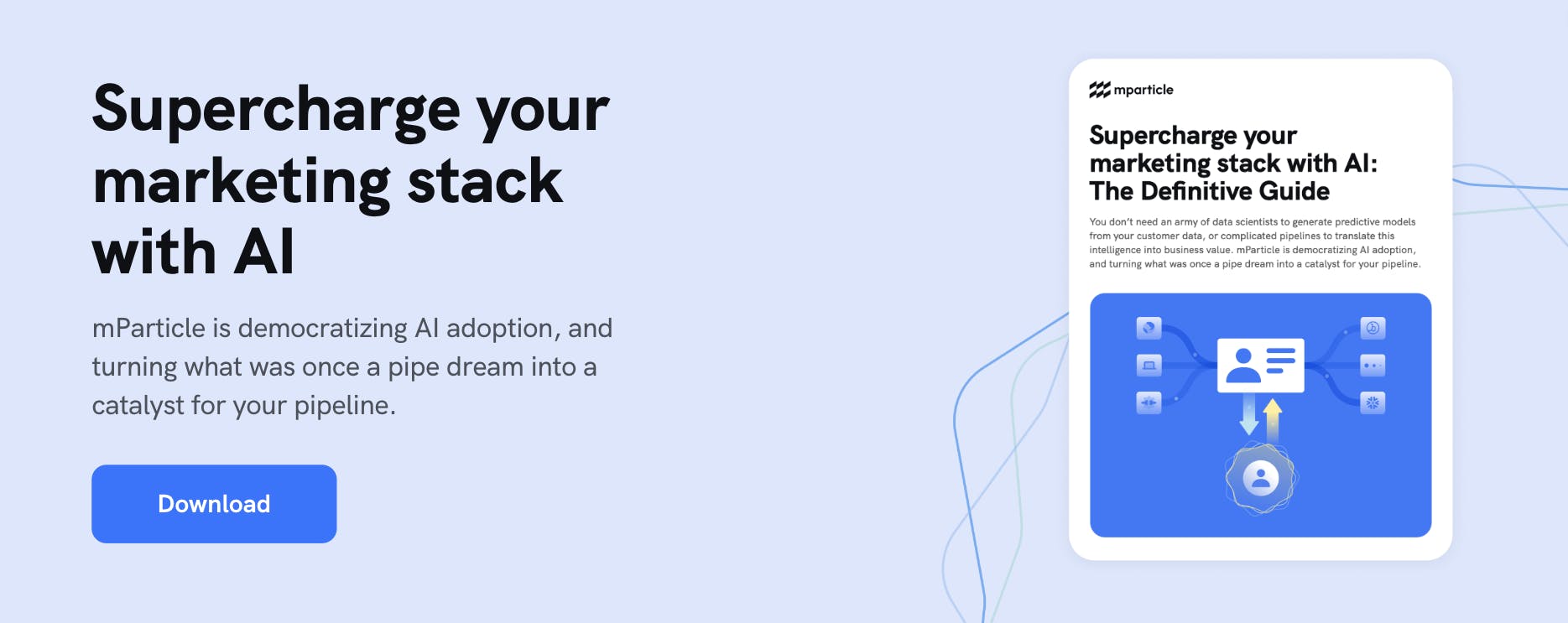What’s the difference between predictive vs. prescriptive analytics?
Understand the difference between predictive analytics and prescriptive analytics and get tips on how you can begin using both types of AI insights to personalize the customer experience.
mParticle Chief Product Officer, Chee Chew, and mParticle Senior Product Marketing Manager, Jonathan Senin, discuss the difference between prescriptive analytics and predictive analytics.
Most marketing and product teams are accustomed to using analytics to understand how users have engaged in the past. By adding Artificial Intelligence (AI) capabilities, teams can go a step further and use customer data to proactively understand how users will engage in the future.
Combining scale and forward-looking analytics is incredibly powerful and can yield big improvements in sales, conversions, customer retention/churn, and more.
For example: Vidora—an AI personalization platform recently acquired by mParticle—has seen customers experience a 400% increase in revenue by switching from historical analysis to future-looking predictions.
As more teams look to bring AI into their marketing strategy, they often get confused by the different types of AI insights available. In particular, we’ve seen marketers wonder about the difference between predictive analytics and prescription analytics, as well as which use cases are best supported by each.
So if your team is ready to get started with AI for your customer data, consider this your crash course in:
- Predictive analytics
- Prescriptive analytics
- Prescriptive on predictive analytics
- How to get started using AI in your marketing
What is predictive analytics?
As Gartner defines it, predictive analytics is any approach to data mining with four attributes:
- An emphasis on prediction (rather than description, classification or clustering)
- Rapid analysis measured in hours or days (rather than the stereotypical months of traditional data mining)
- An emphasis on the business relevance of the resulting insights (no ivory tower analyses)
- (increasingly) An emphasis on ease of use, thus making the tools accessible to business users.
Predictive analytics uses data to make—you guessed it—predictions about what someone will likely do and how they’ll behave in the future.
For example, marketing and product teams may use predictive analytics tools to figure out how likely individual customers are to churn and even when they’re most likely to churn.
But getting these predictions, while helpful, is really just the beginning. To create better experiences and improve metrics like revenue or churn, you need to know how to use those predictions in the right way to create the business outcome you’re looking for (which is the whole purpose of analytics in the first place!)
What is prescriptive analytics?
That’s where prescriptive analytics step in. Per Gartner, prescriptive analytics encompasses “a form of advanced analytics which examines data or content to answer the question ‘What should be done?’ or ‘What can we do to make ____ happen?’”
In practical terms, prescriptive analytics involves recommending a tactic that can be used to spur certain behavior from customers.
So while predictive analytics say Customer A is 80% likely to churn, prescriptive analytics identify the specific actions marketers or product managers can proactively take to reduce that percentage and make it less likely Customer A will churn. For example, prescriptive analytics may suggest you deliver an email—with this particular subject line on this particular date—to Customer A in order to reduce the likelihood that they churn.
And all of this happens well before Customer A actually churns.
What is prescriptive on predictive?
Prescriptive on predictive combines these two kinds of forward-looking analysis in a way that can make it radically easy to prioritize campaigns and invest in the necessary resources. It says, “We prescribe that you do this—and if you do, we predict that customer behavior will change in this certain way.”
Continuing with our example from above, prescriptive on predictive would say if you do deliver this email to Customer A, we predict their likelihood to churn will decrease by 30%.
Using predictive and prescriptive analytics together in this way helps to activate your analytics and prioritize the campaigns and tactics that will have the most impact, helping marketers move the needle on business goals.
How can you start using AI insights in your marketing programs?
AI offers a different paradigm you can leverage in your marketing. Traditional analytics is, fundamentally, looking backwards in time—AI allows you to look forward, to predict the future, and to adapt to users as they change over time.
Despite interest in leveraging AI, teams today face a number of challenges in getting started, including:
- Lack of engineering and data science resources
- Siloed data keeping insights locked away in a single platform
- Overly technical AI solutions that don’t encourage broad adoption
- Lack of quality data on which to base AI insights
- No unified view of the customer
It can be helpful to start by implementing an AI CDP that unifies your customer data and enables you to leverage AI insights throughout your data stack, which goes a long way toward solving for those barriers.
Activating those insights requires a mindset shift away from “I have a campaign, who can I send it to?” toward “I have this insight about certain customers, what can I say to them?” In so doing, you can unlock a whole new level of personalization for your customers.
- Proactive churn reduction: Historical analysis helps you target customers who’ve already churned with re-engagement campaigns. AI allows you to predict churn before it happens and proactively target individual customers before you lose them.
- Predictive ad spend: With ad costs rising, it’s more important than ever to allocate your budget toward customers with the highest likelihood of converting—predictive analytics can help you do that.
- Smarter, scalable recommendations: Predictive modeling powers personalized in-app and other product recommendations that have the highest likelihood of leading to a purchase, and it does so at scale.
- Revenue optimization: Individual-level predictive scoring helps you avoid wasting discounts on customers likely to convert without them, so you can use those offers to convert customers who otherwise may not buy.
Let’s say, for example, you’re launching a new product and you want to create a segment for your email campaign with the customers most likely to be interested in it. Without AI, you might look up who’s bought similar products in the past and build your list based on that. That’s a perfectly adequate way to build your list—but you may also miss a large chunk of people who haven’t purchased a similar product before but are also very likely to be interested in the new product.
With AI insights, you can build models to predict each user’s individual likelihood of purchasing this new product. Some of those folks may have never bought a similar product in the past—but they have similar activity to those who did purchase a similar product. In this way, you can identify a larger group of high-potential buyers to target with your email campaign.
To learn more about how to make AI insights a part of your strategy, you can check out this webinar, Bringing AI to your marketing stack, in which mParticle CPO Chee Chew (ex. Amazon, Google) and Vidora CEO Alex Holub break down AI tactics and tooling.




